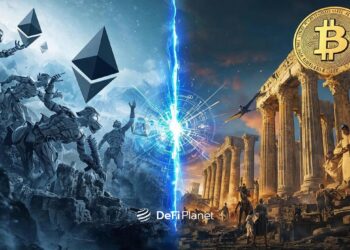Bitcoin has long been the go-to digital asset for institutional investors, viewed as a digital store of value and hedge against inflation. Major players like BlackRock and MicroStrategy have reinforced this dominance by allocating significant capital to BTC. Today, Bitcoin remains the largest component of institutional crypto portfolios, often accounting for more than 35% of total digital asset allocations.
As digital asset markets mature, institutional investors are increasingly exploring assets beyond Bitcoin. The spotlight is widening to include cryptocurrencies that offer more than just store-of-value features, namely, Ethereum. The altcoin combines monetary utility with real-world applications, from DeFi and tokenization to staking yields and smart contract programmability.
For long-term investors seeking both innovation and network value, Ethereum presents a compelling case, and it may be time for it to take a larger role in institutional crypto portfolios.
Ethereum’s Expanding Utility
Ethereum has transformed from a simple cryptocurrency into a versatile blockchain platform powering a wide-ranging ecosystem of decentralized solutions.
Foundation for Smart Contracts and dApps
Launched in 2015, Ethereum’s innovation lies in its Turing-complete smart contracts that support decentralized applications (dApps) across finance, governance, identity, and more. These self-executing contracts have enabled developers to build services directly on-chain without relying on centralized servers.
DeFi Dominance: Lending, Trading, and Yield Protocols
Ethereum remains the backbone of DeFi, with over $80 billion in total value locked (TVL) across key platforms like Aave and Uniswap. Aave, Ethereum’s leading lending protocol, recently surged to over $24 billion TVL, generating more than $1 million in daily fees, while Uniswap handles over $38 billion in monthly trading volume.
These figures highlight Ethereum’s resilience and central role in supporting major financial use cases beyond simple value transfer.
Catalyzing NFTs, Gaming, DAOs, and Real-World Asset Tokenization
Ethereum is also the engine behind the booming NFT and DAOs ecosystem through widely adopted standards like ERC-721, which powers unique tokens for digital art, collectibles, and virtual assets.
Additionally, enterprises and creators are exploring tokenizing real-world assets, such as art, real estate, or commodities, on Ethereum, unlocking liquidity and access in new ways.
Beyond Digital Gold: Comparing Ethereum and Bitcoin
Unlike Bitcoin, which primarily serves as a store of value or “digital gold,” Ethereum offers far greater utility through its programmable blockchain.
While Bitcoin’s functionality is limited to peer-to-peer payments, Ethereum enables developers to create bespoke financial instruments, governance models, and applications, thereby empowering a richer and more dynamic digital economy.
Proof-of-Stake: A Game-Changer for ESG-Conscious Investors
Ethereum’s long-awaited transition to proof-of-stake, known as The Merge, slashed its energy use by over 99%, radically transforming it into one of the greenest blockchain networks available.
Massive Energy Savings
Before The Merge, Ethereum operated on a proof-of-work (PoW) system similar to Bitcoin’s, which required enormous computing power to validate transactions. This meant large mining farms consuming vast amounts of electricity to keep the network secure.
With the switch to proof-of-stake (PoS), Ethereum eliminated the need for energy-hungry mining equipment, cutting its electricity usage. This leap in efficiency makes Ethereum one of the most environmentally friendly blockchains, setting a benchmark for sustainability in the crypto space.
Attracting Institutional Capital with ESG Mandates
Environmental impact has become a central concern for institutional investors, especially those managing large pension funds, endowments, and ESG-focused portfolios. Many were previously hesitant to enter the crypto space due to Bitcoin and Ethereum’s high carbon footprints under PoW. Ethereum’s move to PoS changes the equation.
The sharp drop in energy consumption removes a major barrier, allowing institutions to consider ETH investments without violating ESG principles. This shift significantly broadens Ethereum’s appeal as a viable, compliant asset for long-term institutional crypto portfolios.
Aligning with Sustainability Goals
Beyond just energy savings, Ethereum’s new consensus mechanism represents a philosophical shift that aligns with the climate goals of the broader financial and tech sectors.
As companies and investors alike face mounting pressure to reduce their carbon footprints and support green initiatives, Ethereum now offers a blockchain solution that aligns with these commitments. It serves as a model for how digital assets can evolve in a way that supports innovation while minimizing environmental harm, a critical requirement for the future of institutional crypto portfolios.
Ethereum as Programmable Infrastructure
While Bitcoin is primarily seen as a digital store of value, Ethereum has evolved into a programmable foundation for building decentralized applications and next-generation financial infrastructure.
More Than a Currency
Ethereum’s core strength lies in its programmability. Unlike Bitcoin, which is primarily used for peer-to-peer payments or as a long-term store of value, Ethereum enables developers to build decentralized applications (dApps) directly on its blockchain.
These apps automate financial services, create digital ownership records, and power everything from DeFi protocols and NFT marketplaces to gaming economies and decentralized autonomous organizations (DAOs). This flexibility transforms Ethereum into a foundational technology layer for the decentralized internet.
Institutional Adoption of Ethereum Infrastructure
Large financial institutions and corporations are beginning to adopt Ethereum-based technologies as part of their infrastructure strategies. BlackRock, for instance, launched its tokenized fund “BUIDL“ directly on Ethereum in 2024, allowing real-world assets to be bought and sold on-chain.
Similarly, the European Investment Bank has issued multiple digital bonds on Ethereum’s public ledger, showcasing its credibility for secure, transparent, and programmable finance. These moves highlight a shift in how legacy players view Ethereum, not as a speculative asset, but as a critical piece of financial infrastructure.
Powering Web3 Through Layer 2s and Stablecoins
Ethereum’s scalability challenges have historically limited adoption, but Layer 2 networks like Arbitrum, Optimism, and Base are changing that. These solutions process transactions off the main Ethereum chain and settle them in batches, reducing costs and increasing speed.
This scalability has enabled Ethereum to support billions of dollars in stablecoins, such as USDC and DAI, while also serving as the base layer for fast and low-cost applications.
As a result, Ethereum is powering the next generation of Web3 services, wallets, games, marketplaces, and DeFi platforms, at a scale that rivals traditional tech platforms.
Risk-Reward Profile and Diversification Benefits
Ethereum offers a compelling risk-reward profile that complements Bitcoin, bringing both potential upside and portfolio resilience.
Higher Beta, Higher Upside Potential
Ethereum typically exhibits a higher beta than Bitcoin, meaning it responds more dramatically to market movements. For example, Ethereum’s annualized volatility has hovered around 59%, compared to Bitcoin’s 42%. While this can mean sharper drops, it also opens the door to outsized gains during bullish cycles, providing an opportunity for higher returns in a balanced portfolio.
Diversification Beyond Bitcoin
Although Ethereum and Bitcoin share market drivers, Ethereum’s performance is increasingly decoupling, especially in real-world growth phases. Data shows that the correlation between ETH and BTC has dropped to around 0.71, down from over 0.9 in prior years.
ETH offers diversification benefits that reduce overall portfolio risk during market stress.
Institutional-Grade Tools: Derivatives, ETFs, and Custody
Growing support infrastructure is making ETH more accessible for institutions. US spot Ethereum ETFs collectively manage several billion dollars, while platforms like GFO-X in London offer regulated ETH derivatives. Major custodians, including Deutsche Börse’s Clearstream, now support institutional-grade storage for ETH, providing the foundational support needed for institutional crypto portfolios.
Why Institutions Are Still Hesitant
Despite Ethereum’s strengths, many institutional investors remain cautious due to concerns over its complexity, scalability, governance, and regulatory framework.
Perceived Complexity
Ethereum’s ecosystem, with its smart contracts, Layer 2 networks, staking mechanisms, and token standards, is far more intricate than Bitcoin’s relatively simple store-of-value model. According to an institutional survey by JP Morgan, 71% of institutional traders say blockchain still feels more conceptual than practical, pointing to unfamiliarity with complex infrastructure as a major barrier to adoption.
Scalability and Competition Concerns
Ethereum continues to face scaling limitations and intense competition from faster and cheaper Layer 1 blockchains, such as Solana and Avalanche. Despite upgrades like Dencun, which reduced Layer 2 fees by over 90%, the shift of activity away from the base layer raises worries about fragmented usage and value capture. Critics suggest that Ethereum’s evolving fee structure and reliance on external roll-ups complicate its long-term institutional utility.
Uncertainty Around Governance and Roadmap
Ethereum’s decentralized governance model has sparked debate. Frequent upgrades, varied development priorities, and community decision-making can slow change or cause internal friction. Some developers warn that complexity and centralized stakeholder influence may undermine Ethereum’s original vision of neutrality . Institutional investors often seek stable, predictable protocols, something Ethereum’s evolving roadmap hasn’t fully provided.
Addressing the Concerns
In response, Ethereum’s community is implementing strategic upgrades and governance models. The Dencun upgrade (March 2024) introduced blob-space to curb Layer 2 fees and enhance scalability. Upcoming Pectra upgrades aim to simplify staking and validator interfaces. Meanwhile, developer-led efforts like R1 rollups and new token standards (ERC‑7828/7930) are improving cross-chain usability and reducing centralization risks.
Final Thoughts
Ethereum has evolved far beyond its origins as a “Bitcoin alternative.” For institutional crypto portfolios seeking exposure not just to digital assets but to the underlying infrastructure of the future financial system, Ethereum presents a compelling case. Its utility in DeFi, NFTs, tokenization, and smart contract platforms gives it a unique position in the blockchain economy, offering an upside that extends well beyond the “digital gold” narrative that defines Bitcoin.
With its transition to proof-of-stake, increasing institutional-grade tooling, and ongoing innovations like Layer 2 scaling and protocol upgrades, Ethereum is becoming more attractive to ESG-conscious, tech-forward investors. For institutions looking beyond digital gold, Ethereum is more than a tech bet; it is exposure to the future of finance. As digital asset markets mature, it may be time for ETH to move from “altcoin” to a core holding in forward-looking institutional portfolios.
Disclaimer: This article is intended solely for informational purposes and should not be considered trading or investment advice. Nothing herein should be construed as financial, legal, or tax advice. Trading or investing in cryptocurrencies carries a considerable risk of financial loss. Always conduct due diligence.
If you would like to read more articles like this, visit DeFi Planet and follow us on Twitter, LinkedIn, Facebook, Instagram, and CoinMarketCap Community.
Take control of your crypto portfolio with MARKETS PRO, DeFi Planet’s suite of analytics tools.”





















